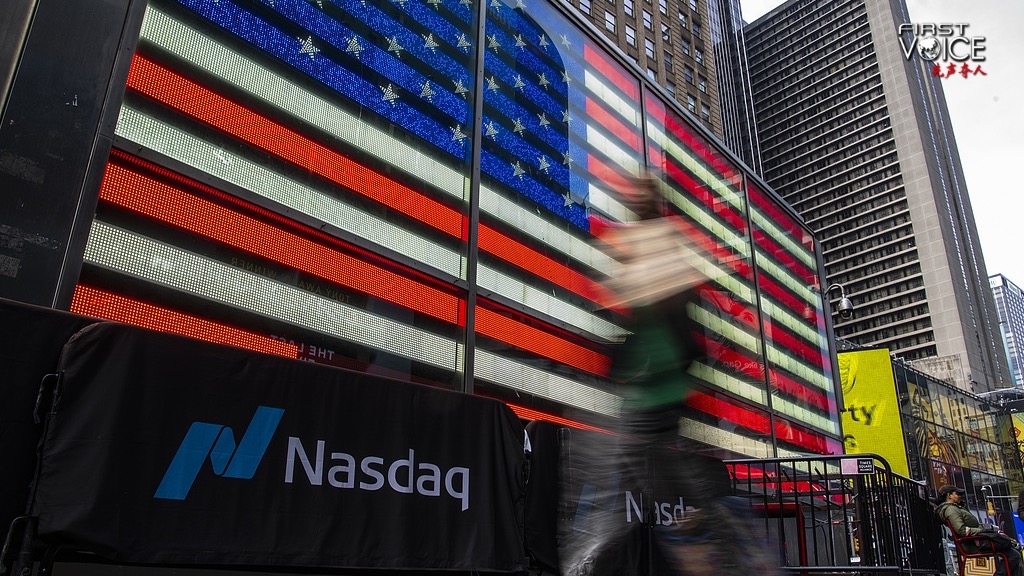Home > > The illusion of fortress America: Why tariff wars reveal U.S. weaknesses
The illusion of fortress America: Why tariff wars reveal U.S. weaknesses

A person walks near a Nasdaq's banner in Times Square in New York City, the United States, April 3, 2025. /CFP
A Chinese e-commerce app, DHgate, has recently surged to the top of the U.S. App Store, driven by viral TikTok trends exposing the origins of luxury goods and revealing how consumers can bypass traditional retail channels to avoid tariff-inflated prices.
This unexpected consumer behavior highlights a key flaw in the U.S. tariff strategy, which aims to revitalize domestic industries but instead reveals fundamental weaknesses in the U.S. economy and the difficulties of controlling consumer choices in a globalized market.
The United States, under the banner of "America First," has increasingly resorted to unilateral tariff impositions, igniting what can only be described as a global trade war. The U.S. seems intent on resetting the world trade order, forcing other nations to choose between continuing economic integration or acquiescing to this new order.
While proponents claim this strategy is a means to revitalize domestic industries, reduce trade deficits and bring back manufacturing jobs, a closer examination reveals fundamental weaknesses within the U.S. economy that these tariffs not only fail to address but actively exacerbate. Indeed, the promised manufacturing renaissance fueled by protectionism is more likely a tantalizing illusion than a tangible reality.
One of the most glaring vulnerabilities exposed by this tariff offensive is the U.S. economy's deep reliance on global supply chains. Decades of prioritizing efficiency and cost-effectiveness have led American businesses to integrate intricate international networks for sourcing components and assembling finished goods. Slapping tariffs on imports disrupts these established flows, leading to increased costs for domestic manufacturers who rely on these inputs.
This, in turn, can stifle their competitiveness, both domestically and internationally, ultimately harming the very industries the tariffs are intended to protect. The idea that American manufacturing can simply decouple from these global webs without significant economic pain is a fallacy.
Moreover, the American consumer bears a significant burden in this trade war. Tariffs are essentially taxes on imported goods, and while foreign exporters may absorb some of these costs, a substantial portion is invariably passed on to American businesses and ultimately to consumers through higher prices. This erodes purchasing power, potentially leading to decreased demand and slower economic growth.
The claim that tariffs will magically lead to a surge in domestic production that entirely replaces imports at comparable prices ignores the fundamental principles of supply and demand and the realities of global cost structures.
Another critical weakness lies in the potential of retaliatory measures from targeted nations. As history has repeatedly shown, trade wars are rarely unilateral. When the U.S. imposes tariffs, other countries are likely to respond in kind, targeting American exports. This not only harms U.S. industries that rely on overseas markets, but can also escalate into a damaging cycle of tit-for-tat tariffs, ultimately shrinking global trade and harming all involved. The notion that the U.S. can unilaterally dictate trade terms without facing significant repercussions is a dangerous miscalculation.
The promise of a large-scale return of manufacturing jobs is arguably the most alluring, yet least likely, outcome of tariff policies. While some reshoring might occur, significant limitations exist. Firstly, the considerably higher labor costs in the U.S. compared to many global manufacturing centers cannot be entirely offset by tariffs.
Secondly, modern manufacturing's increasing reliance on automation and capital-intensive processes fundamentally alters the labor landscape. The U.S. Treasury Secretary's own acknowledgment of a tight labor market and the necessity of automation and robotics to enhance efficiency directly contradict the vision of a massive resurgence in blue-collar jobs. While some skilled technician roles will be created, the notion of millions of manufacturing jobs returning is unrealistic given current production trends.
The Secretary's assertion that a lack of skilled workers necessitates automation further underscores a key contradiction. If job creation is a primary goal of tariffs, then promoting automation, which inherently reduces the need for human labor, undermines this objective. While workforce training is essential, the scale and time required to equip a workforce for highly automated manufacturing raise doubts about its ability to generate the vast number of jobs attributed to reshoring.
Ultimately, tariffs fail to address the underlying structural challenges hindering a U.S. manufacturing renaissance. Issues like the shortage of skilled labor, inadequate infrastructure and a complex regulatory environment are significant impediments that protectionist trade measures cannot resolve. These are domestic issues that require targeted investment and policy reforms, not simply the imposition of tariffs on foreign goods.

A Chinese e-commerce app, DHgate, is suddenly atop the U.S. App Store as tariff fears push U.S. consumers to opt for Chinese products, April 17, 2025. /CFP
While the rhetoric surrounding America's tariff war may paint a picture of renewed industrial might and economic independence, the reality is far more complex. The strategy exposes fundamental weaknesses in the U.S. economy, including its reliance on global supply chains, the burden on consumers and the inevitability of retaliation. The promise of a massive return of manufacturing jobs is likely to be an overblown claim, especially given the increasing role of automation.
Instead of building a fortress America through protectionist policies, the U.S. would be better served by addressing its underlying economic vulnerabilities through strategic investments in education, infrastructure and innovation, fostering genuine competitiveness in the global marketplace rather than resorting to the illusion of prosperity behind tariff walls. The grand vision of a tariff-fueled manufacturing revival is a tempting but ultimately unsustainable fantasy.
(CGTN's First Voice provides instant commentary on breaking stories. The column clarifies emerging issues and better defines the news agenda, offering a Chinese perspective on the latest global events.)
CGTN 2025-04-24